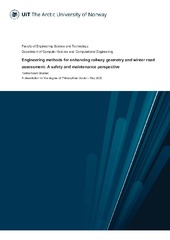| dc.contributor.advisor | Godtliebsen, Fred | |
| dc.contributor.author | Drangsholt, Preben | |
| dc.date.accessioned | 2022-11-04T07:17:40Z | |
| dc.date.available | 2022-11-04T07:17:40Z | |
| dc.date.issued | 2022-07-13 | en |
| dc.description.abstract | Type 1 diabetes (T1D) is a chronic autoimmune disease that leads to insulin deficiency. Consequently, the disease will lead to a poor blood glucose (BG) regulation, and in situations of high energy expenditure like exercise, a dysfunctional regulation can cause severe damage or death [5] [14].
Diabetes is responsible for one death every five seconds and financially drains approximately 11% of the global health expenditure [9]. This adversity is subject to a great quantity of research, but is seemingly incurable. Therefore, symptom control treatments are salient. However, there is currently no fully individualized autonomous solution to the management of the disease.
In this thesis, we present and develop a way of optimizing BG regulation that is fitted to one specific patient. We combine the use of a published mathematical model that models BG as a function of heart rate (HR), insulin injections and carbohydrate (CHO), with artificial intelligence to give the patient a recommended amount of CHO before any given exercise. We also do a statistical optimization of the BG optimization and compare both results.
The results are promising, but additional validation is needed before completely trustworthy conclusions can be made. However, the product is a valuable decision support system that the patient can use, and the methodology presents a way to adapt the product to other patients. | en_US |
| dc.identifier.uri | https://hdl.handle.net/10037/27244 | |
| dc.language.iso | eng | en_US |
| dc.publisher | UiT Norges arktiske universitet | no |
| dc.publisher | UiT The Arctic University of Norway | en |
| dc.rights.holder | Copyright 2022 The Author(s) | |
| dc.rights.uri | https://creativecommons.org/licenses/by-nc-sa/4.0 | en_US |
| dc.rights | Attribution-NonCommercial-ShareAlike 4.0 International (CC BY-NC-SA 4.0) | en_US |
| dc.subject.courseID | STA-3941 | |
| dc.subject | VDP::Mathematics and natural science: 400::Mathematics: 410::Statistics: 412 | en_US |
| dc.subject | VDP::Matematikk og Naturvitenskap: 400::Matematikk: 410::Statistikk: 412 | en_US |
| dc.subject | VDP::Mathematics and natural science: 400::Mathematics: 410 | en_US |
| dc.subject | VDP::Matematikk og Naturvitenskap: 400::Matematikk: 410 | en_US |
| dc.subject | VDP::Mathematics and natural science: 400::Mathematics: 410::Applied mathematics: 413 | en_US |
| dc.subject | VDP::Matematikk og Naturvitenskap: 400::Matematikk: 410::Anvendt matematikk: 413 | en_US |
| dc.subject | VDP::Mathematics and natural science: 400::Information and communication science: 420::Mathematical modeling and numerical methods: 427 | en_US |
| dc.subject | VDP::Matematikk og Naturvitenskap: 400::Informasjons- og kommunikasjonsvitenskap: 420::Matematisk modellering og numeriske metoder: 427 | en_US |
| dc.title | Personalized optimization of blood glucose regulation: A Diabetes Mellitus case study | en_US |
| dc.type | Mastergradsoppgave | nor |
| dc.type | Master thesis | eng |


 English
English norsk
norsk



